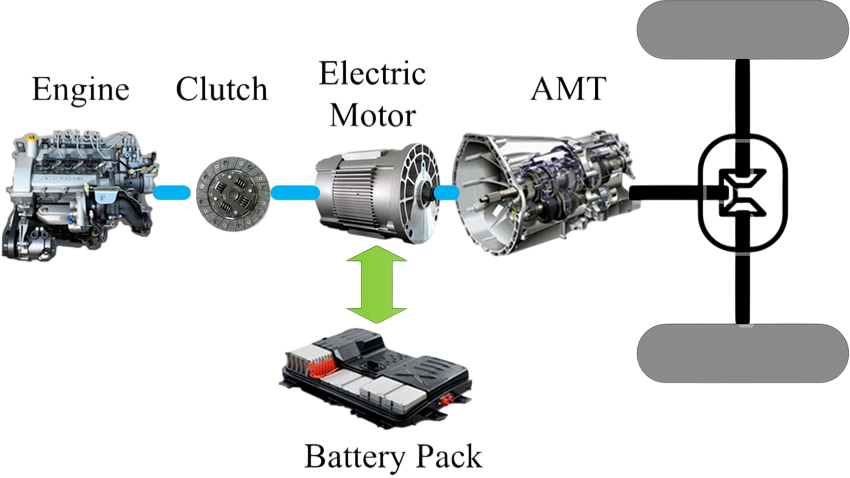
- Definition and Concept
- Difference Between PHEV and HEV
- Components of PHEV
- Battery and Engine Integration
- Charging Mechanism
- Energy Management System
- Fuel Efficiency and Emissions
- Driving Range and Modes
- Market Examples of PHEVs
- Pros and Cons
- Future of PHEVs
- Conclusion
Definition and Concept
Plug-in Hybrid Electric Vehicles (PHEVs) are a class of hybrid vehicles that combine a traditional internal combustion engine (ICE) with an electric motor and a rechargeable battery that can be charged by plugging into an external power source. Unlike conventional hybrids, PHEVs offer a greater electric-only driving range and can operate independently on electric power for shorter trips. To explore how intelligent systems optimize plug-in hybrid performance through predictive energy management, smart charging strategies, and adaptive control, explore Artificial Intelligence Training a hands-on course that covers machine learning, embedded AI, and sustainable mobility applications for next-generation hybrid and electric vehicles. This dual-system approach allows drivers to benefit from the fuel efficiency of electric vehicles while maintaining the extended range capability of gasoline engines. PHEVs bridge the gap between battery electric vehicles (BEVs) and hybrid electric vehicles (HEVs), serving as a transitional technology in the journey towards full electrification of transportation.
Difference Between PHEV and HEV
Understanding the difference between PHEVs and HEVs is important for assessing their uses. To explore how control units, sensors, and real-time processors manage these hybrid systems and optimize performance, explore Embedded Systems in Electric Vehicle a comprehensive guide that explains microcontrollers, power electronics, communication networks, and the critical role of embedded intelligence in enabling efficient hybrid and fully electric mobility. HEVs (Hybrid Electric Vehicles) use regenerative braking and the internal combustion engine to charge the battery. They cannot be charged from external sources. PHEVs (Plug-in Hybrid Electric Vehicles) have a larger battery that can be recharged from the grid. This feature allows for longer electric-only driving.
| Feature | HEV | PHEV |
|---|---|---|
| Charging Method | Regenerative Braking | Plug-in + Regenerative Braking |
| Electric Range | Short (1–3 miles) | Moderate (20–50+ miles) |
| Battery Size | Small | Larger |
| Fuel Use | Primarily ICE | Reduced ICE usage |
| Emissions | Lower than ICE | Lower than HEV |
Ready to Get Certified in Artificial Intelligence ? Explore the Program Now Artificial Intelligence Online Training Offered By ACTE Right Now!
Components of PHEV
PHEVs consist of several integrated components that work in harmony, including the internal combustion engine, electric motor, battery pack, and control systems that coordinate power delivery. To understand how these elements are monitored, optimized, and scaled across multiple vehicles in business operations, explore What is EV Fleet Management a comprehensive guide that explains fleet monitoring, telematics, charging strategies, cost optimization, and the technologies enabling efficient large-scale EV adoption.
- Internal Combustion Engine (ICE): Provides power during long trips or when the battery is depleted.
- Electric Motor/Generator: Propels the vehicle during electric-only operation and assists the ICE.
- Traction Battery Pack: Stores electricity for the electric motor.
- Onboard Charger: Converts AC from the grid into DC for battery charging.
- Power Electronics Controller: Manages the flow of electricity between components.
- Transmission System: Transfers torque to the wheels.
- Cooling System: Manages heat in battery and power electronics.
- Parallel Hybrid Systems: Both the motor and engine can drive the vehicle simultaneously.
- Series Hybrid Systems: The ICE generates electricity but does not drive the wheels directly.
- Series-Parallel Systems: Combines both methods for improved flexibility.
- Fuel Efficiency: Can exceed 100 MPGe (Miles Per Gallon equivalent) in electric mode.
- Emissions: Lower CO₂ and NOₓ emissions, particularly in urban stop-and-go traffic.
- Hybrid Mode: Allows for extended driving with minimized reliance on gasoline.
- Electric-Only Mode (EV Mode): Zero-emissions driving for short distances.
- Hybrid Mode: Uses a combination of ICE and electric motor.
- Charge Hold Mode: Preserves battery charge for later use (e.g., city driving).
- Fuel Savings: Reduced fuel costs over time.
- Electric Drive Option: Ideal for short daily commutes.
- Extended Range: No range anxiety compared to BEVs.
- Lower Emissions: Especially in urban driving.
- Flexible Refueling: Can use electricity or gasoline.
- Higher Initial Cost: Due to complex drivetrain.
- Limited Electric Range: Less than BEVs.
- Battery Replacement Costs: Potential long-term expense.
- Weight: Dual powertrain adds to vehicle weight.
- Incentives: May not be as substantial as for BEVs in some regions.
- Battery Advancements: Improved energy density may extend electric-only range.
- Government Policies: May favor BEVs with stricter emission norms.
- Consumer Demand: Driven by affordability, infrastructure, and awareness.
- Software Innovations: Smarter EMS for better efficiency.

To Explore Artificial Intelligence in Depth, Check Out Our Comprehensive Artificial Intelligence Online Training To Gain Insights From Our Experts!
Battery and Engine Integration
The integration of the battery and engine in a PHEV is engineered to optimize efficiency and performance. The electric motor typically handles low-speed, short-distance driving, while the ICE kicks in at higher speeds or when additional power is needed. To explore how these dual systems are coordinated through advanced propulsion design, explore EV Powertrain a comprehensive guide that explains motor types, transmission systems, energy flow, and the technologies enabling seamless transitions between electric and combustion power.
This integration is controlled by sophisticated energy management software that decides when to use which power source based on driving conditions.
Charging Mechanism
Charging a Plug-in Hybrid Electric Vehicle (PHEV) involves connecting the vehicle to an external power source, and there are several options to meet different needs. The simplest method is Level 1 charging, which uses a standard 120V outlet. This method is convenient, but it usually takes 6 to 12 hours to reach a full charge. For those who want faster charging, Level 2 charging stations offer a better solution. To explore how intelligent systems optimize EV charging through predictive load management, smart grid integration, and adaptive scheduling, explore Artificial Intelligence Training a hands-on course that covers machine learning, embedded AI, and intelligent energy solutions for advanced charging infrastructure. These operate at 240V and cut the charging time down to just 2 to 4 hours. PHEVs also have regenerative braking technology, which captures energy during braking and turns it into electricity. This feature improves their efficiency. Most PHEVs do not support DC fast charging because of their smaller batteries, but their lower charging needs mean that even basic home setups are often enough for daily use. This mix of charging options and technologies makes owning a PHEV a practical choice for many drivers.
Energy Management System
The Energy Management System (EMS) plays a key role in improving the efficiency and performance of vehicles by managing different energy sources and processes. One of its main jobs is to decide the best times to switch between electric power and internal combustion engine (ICE) power. This helps the vehicle run at its peak efficiency in different conditions. To understand how this decision-making process connects with energy flow, charging strategies, and overall efficiency, explore Electric Vehicle Charging a comprehensive guide that explains charging methods, infrastructure, smart charging systems, and the role of optimized energy management in hybrid and fully electric vehicles. The EMS also calculates how much energy can be recovered during braking. This not only helps save energy but also boosts overall vehicle performance. It manages the charging and discharging cycles of the battery to keep it healthy and extend its lifespan. The system also includes thermal management strategies to avoid overheating, protecting the vehicle’s components. By using software that relies on sensors and predictive algorithms, the EMS enables smooth transitions between power sources while greatly improving fuel economy. This makes it a crucial part of modern vehicle design.
Looking to Master Machine Learning? Discover the Artificial Intelligence Expert Masters Program Training Course Available at ACTE Now!
Fuel Efficiency and Emissions
PHEVs significantly reduce fuel consumption and greenhouse gas emissions compared to ICE vehicles:
Efficiency depends on driving habits. Short urban trips yield maximum benefit due to greater use of electric mode.
Driving Range and Modes
PHEVs offer flexible driving experiences:
Typical electric range is 30–60 km. Total range (ICE + electric) often exceeds 500 km, making PHEVs ideal for mixed-use scenarios.
Preparing for Artificial Intelligence Job Interviews? Have a Look at Our Blog on Artificial Intelligence Interview Questions and Answers To Ace Your Interview!
Market Examples of PHEVs
Several manufacturers offer plug-in hybrid electric vehicles (PHEVs) across various segments, reflecting the rising interest in this eco-friendly technology.Notable examples include the Toyota Prius Prime, a pioneer in the PHEV category, and the Mitsubishi Outlander PHEV, a popular SUV with all-wheel drive. To understand how these vehicles rely on intelligent systems to manage power distribution, motor control, and seamless transitions between electric and combustion modes, explore Electric Vehicle (EV) Controller a comprehensive guide that explains controller architecture, signal processing, efficiency optimization, and the critical role of controllers in modern hybrid and fully electric vehicles. Luxury brands are also entering the market with models like the BMW 330e and 530e, both of which provide impressive electric performance, and the Volvo XC90 Recharge, a premium SUV with a 60 km electric range. In India, the trend is evolving too, with high-end PHEVs like the Volvo XC60 and S90 Recharge making their mark, along with the Toyota Camry Hybrid, which comes in a strong hybrid configuration.
Pros and Cons
Advantages:
Disadvantages:
Future of PHEVs
The future of PHEVs will depend on several factors: advancements in battery technology, charging infrastructure, government policies, and consumer adoption trends. To explore how these elements are shaping innovation and hands-on learning opportunities in the EV sector, explore Electric Vehicle Projects a comprehensive guide that highlights real-world EV prototypes, student and industry projects, system design approaches, and the practical applications driving the next generation of electric mobility.

PHEVs may serve as an important transitional technology, especially in markets with limited charging infrastructure. However, as BEV technology becomes more affordable and widespread, PHEVs may gradually
Plug-in Hybrid Electric Vehicles offer a balanced approach to sustainable mobility. With their dual power sources, they provide a practical solution for those who want to experience electric driving without full dependence on charging infrastructure. To explore how intelligent systems optimize PHEV performance through predictive energy management, smart charging strategies, and adaptive control, explore Artificial Intelligence Training a hands-on course that covers machine learning, embedded AI, and sustainable mobility applications for hybrid and electric vehicles. As technologies mature and emissions regulations tighten, PHEVs are likely to play a crucial, if transitional, role in the global shift toward electric mobility.
Conclusion




